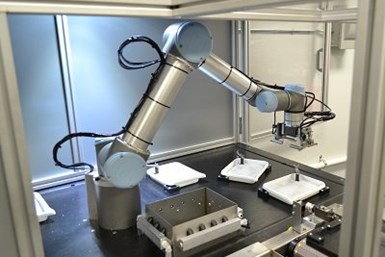Automate Your Brush Plating Operation
Derek Kilgore from Sifco ASC says the brush plating operation can be mechanized, semi-automated or even fully automated.
Q: Can I automate my brush plating operation?

A: The short answer is yes. The brush plating operation can be mechanized, semi-automated or even fully automated. But first you have to ask yourself a few additional questions with your application in mind. A major consideration is practicality – does it make sense to automate your application? Can it be done? Should it be done? Typical reasons for automating a brush plating application include improving quality and consistency, increasing operator safety and improving process throughput.
Through the mechanization of the process, the operator’s direct contact with tooling and chemicals is significantly reduced. Instead, a computer program – which can be configured by the operator – controls the volts, amps, polarity and ampere hours required for the specific application, including preparatory and plating steps.
In practice, this removes the potential for human error and variability from the process, making the operation more reliable and consistent. By accurately controlling the level of deposits with little operator involvement, results are more consistent, thereby driving greater levels of quality for every operation. With the introduction of data logging to the process, automated selective plating also provides full component and process traceability through constant system data monitoring.
Alongside the improved operation results brought about by automation, operator safety is also elevated. Operator safety not only includes removing the operator from the chemicals but also improves operator ergonomics. Reducing risk to the operator by removing them from repetitive tasks and ergonomically unfavorable positions increases the capacity of skilled workers to focus on other business areas. In turn, mechanical systems are able to replicate the application process identically every time, ensuring high levels of consistency without the need for operator intervention.
As well as improving working conditions and safety for operators, automation also leads to greater levels of efficiency and profitability. Mechanized setups allow for operations to run smoothly and consistently until completion, making for greater levels of productivity and the potential for reduced lead times.
Looking more closely at the operation itself, an automated approach also opens up opportunities for improving process throughput. Robotic equipment, which is capable of working around the clock until the completion of a particular application, also utilizes chemicals more efficiently, using only the volumes required at each stage of the selective plating process — effectively removing bottlenecks and increasing throughput.
Generally, good candidates for automation will have most or all of the following characteristics:
- Relatively simple shape (ID, OD, flat).
- Low to medium volume of parts.
- Not too many different part configurations.
- Low deposit thickness.
Once it is determined that the part is suitable for automation, then it’s a question of evaluating the current state and then understanding what the future state needs to look like. There is a significant amount of information gathering and conceptualization that needs to be done to determine options for automation.
So, in this time when industry is seeing the benefits of automating traditionally labor-intensive processes, selective plating can now be considered a state-of-the-art solution that can be semi-automated or fully automated for specific applications.
Derek Kilgore is a mechanical design and project engineer at Sifco ASC. Visit sifcoasc.com
Related Content
Possibilities From Electroplating 3D Printed Plastic Parts
Adding layers of nickel or copper to 3D printed polymer can impart desired properties such as electrical conductivity, EMI shielding, abrasion resistance and improved strength — approaching and even exceeding 3D printed metal, according to RePliForm.
Read MoreLiquid Chrome Vs. Chromic Acid Flake
Contemplating how to continue offering chromic acid services in an increasingly stringent regulatory world? Liquid chrome products may be the solution you’re looking for.
Read MoreAdvantages to Pumped Eductor Agitation
Not all agitation methods are created equally. Pumped agitation with eductor nozzles can improve process tanks and quickly show a reduction in operating costs while keeping staff safe, following environmental legislation and preventing pollution.
Read MoreTrivalent Chrome Overview
As the finishing industry begins to move away from the use of hexavalent chromium to trivalent chromium, what factors should finishers consider as they make new investments? Mark Schario, chief technology officer for Columbia Chemical offers a helpful overview of this complicated topic.
Read MoreRead Next
Education Bringing Cleaning to Machining
Debuting new speakers and cleaning technology content during this half-day workshop co-located with IMTS 2024.
Read MoreA ‘Clean’ Agenda Offers Unique Presentations in Chicago
The 2024 Parts Cleaning Conference, co-located with the International Manufacturing Technology Show, includes presentations by several speakers who are new to the conference and topics that have not been covered in past editions of this event.
Read MoreDelivering Increased Benefits to Greenhouse Films
Baystar's Borstar technology is helping customers deliver better, more reliable production methods to greenhouse agriculture.
Read More










.jpg;maxWidth=300;quality=90)










